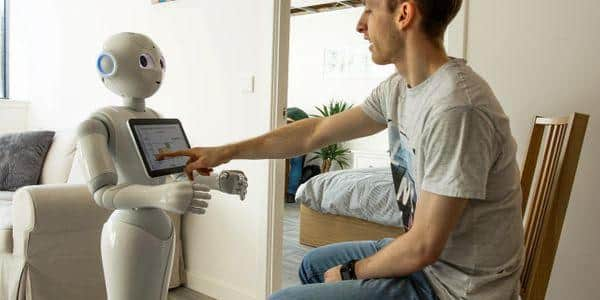Heriot-Watt’s National Robotarium to show real-life AI


Experts say yes – that robotic and AI technology is there to raise the alarm if someone has had a serious fall, or to highlight a potential deterioration in their health.
Lynne Baillie, Professor of Computer Science at Heriot-Watt University, says the opening of the National Robotarium at the Heriot-Watt campus in Edinburgh in spring 2022, will showcase this exciting potential.
“The National Robotarium can show how things can work in real life, with a series of linked 'living labs' replicating people’s homes, hospital bays, workplaces and more - demonstrating human-robot interaction.”


Heriot-Watt already has an assisted living apartment on campus, which uses robots and sensors to replicate real-life situations: “We can collect data from sensors and robots and see what interaction people have; our ultimate goal is to help people to 'age in place' in their home."
Spotting patterns
Baillie gives a clear example: “The aim is to help with diagnosis and support people as they go through different stages of a disease or condition, such as dementia. By using sensors to monitor daily activities, we know if people are getting up and going to the bathroom, turning on the cooker or opening the fridge.
“If there are unusual patterns, you can activate a social robot that can ask the person questions about why things are different. It might be that the person has moved from one level of dementia to another and the robot can help to identify that and alert medical professionals.
"You could also use social robots where someone has had a fall. You could programme it to check if someone gets up after the fall and, if a certain time passes with no movement, the social robot can send an alert."
Baillie says privacy is a key consideration: "We only want to collect data we need. In the assisted living environment at the university, we collect all the data we want, but in real-life environments we need to collect only what is acceptable and appropriate to individuals. This is not intrusive - it's about using robots to give people the support they need."
Long-Covid support
There are real opportunities for robotics in hospital and care settings too, Baillie says. For example, the Pepper robot has a built-in tablet that can be used for video calls with loved ones, without a nurse or nurse assistant having to hold up the tablet, and the device can be cleaned easily afterwards.
Covid-19 has definitely led to a renewed interest in robotics from the medical profession, says Baillie, in areas like monitoring and supporting patients with 'Long Covid'. She suggests robots could also help with social distancing in certain settings: “If someone is standing too close to you, could a robot intervene and tell them, removing that human awkwardness?
“Our research has used robots in a wide range of healthcare settings including supporting patients to continue their rehabilitation exercises between physiotherapy visits. This project showed that the patients who had additional robotic support experienced better outcomes than those without.
“By complementing existing care packages, and creating technology in partnership with NHS professionals, we are confident that robots and AI can help both health care professionals and patients, as technology becomes increasingly sophisticated.”
NHS Lothian
Heriot-Watt is currently working very constructively with a range of medical professionals, including a team at NHS Lothian tasked with investigating technology innovation and patient care.
Baillie says the development of the National Robotarium is very timely: “I really hope it can act as an ice-breaker and a demonstrator to push the healthcare agenda forward, to show what can be achieved. By linking together the ‘living labs’, we will allow a wide range of professionals to see and understand, in real-life settings, what can be done by robots in a very practical way.
“This could include health professionals, community care workers, charities, housing associations and many more. We need to bring a whole lot of different people to the table to get this technology really embedded into service delivery - and the National Robotarium could be the big push needed to make it happen.
"There is a growing understanding that we need to use robotics much more in healthcare.
"The ageing population presents real resource challenges, in terms of both funding and people, and technology can help us to bridge the gap to deliver better patient care.”
Find out more at www.hw.ac.uk/nationalrobotarium